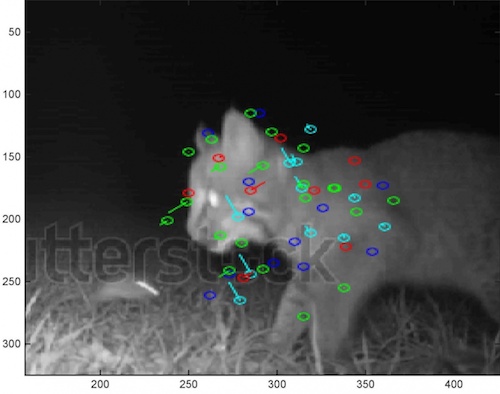Jon Cafaro
 We are interested in how populations of retinal ganglion cells encode stimulus information in natural contexts. The figure shows the responses of a large population of direction selective retinal ganglion cells in response to a video of a cat pursuing its prey. There are 4 cell types (indicated by color), each cell type preferring 1 of 4 cardinal directions. A circle indicates the position of each cell, the length of the line emanating from the circle indicates the strength of its response, and the direction of the line indicates the cells preferred direction of response. The mouse brain must extract the cat’s movement from this population of cells but it is unclear how that can be done. The responses of these cells can be well predicted during simple light stimuli but such models fail during complex natural stimuli. We hope to find models of neural populations that are able to extend predictions from simple to natural stimuli conditions.
We are interested in how populations of retinal ganglion cells encode stimulus information in natural contexts. The figure shows the responses of a large population of direction selective retinal ganglion cells in response to a video of a cat pursuing its prey. There are 4 cell types (indicated by color), each cell type preferring 1 of 4 cardinal directions. A circle indicates the position of each cell, the length of the line emanating from the circle indicates the strength of its response, and the direction of the line indicates the cells preferred direction of response. The mouse brain must extract the cat’s movement from this population of cells but it is unclear how that can be done. The responses of these cells can be well predicted during simple light stimuli but such models fail during complex natural stimuli. We hope to find models of neural populations that are able to extend predictions from simple to natural stimuli conditions.
Suva Roy

My research broadly focuses on understanding how different retinal circuits support diverse visual computations. I am also interested in exploring the cellular and circuit mechanisms underlying retinal diseases, to identify potential therapies.
Xiaoyang Yao
The left image shows a retinal ganglion cell's electrical image, from which we can estimate the location of that cell on electrode array. In the right image, electrical images of all retinal ganglion cells from the same functional type were aligned with fluorescent image of the same retina of a transgenic mouse. In this way, the morphological and functional types were matched.